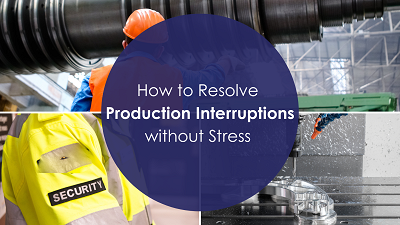How to Resolve Production Interruptions Without Stress

In today’s fast-paced manufacturing environment, production interruptions can be a significant challenge.
As an operations manager or general manager, your primary goal is to keep production running smoothly, make the business as efficient as possible, and get the most out of your staff. However, security issues can often disrupt this flow, leading to costly downtime and inefficiencies.
Why Security Matters
Many people think security is only important when there’s a problem. But waiting until something goes wrong can be a big mistake. Security problems, like hacking or break-ins, can stop production, damage equipment, and steal important information. It’s better to be ready before anything bad happens.
Three Tips to Prevent Security Disruptions
Here are three tips to help ensure that security doesn’t cause a disruption to your production and lead to stress:
The Convergence of Physical and Cyber Security
Security in manufacturing is no longer just about physical barriers. With the rise of digital innovation, cyber threats have become just as significant. When considering how to prevent disruptions to production you should consider both physical and cyber risks as one. This approach helps you find the perfect balance between security investment and operational efficiency. By implementing this robust framework, you can ensure that your operations withstand any incidents, allowing your staff to focus on their core responsibilities.
Other blogs you may be interested in:
- Navigating Client Security Mandates: A Roadmap for Manufacturing Firms
- How Procurement or Facilities Managers Can Close Security Gaps in Manufacturing with Ease
- How to Resolve Cyber Vulnerabilities with PREAPRED Methodology without Panic
Turning Security Threats into Manageable Risks
Many managers think, “If it’s not broken, don’t fix it,” or “It won’t happen to us.” However, security breaches, whether cyber or physical, can halt production, damage equipment, and compromise sensitive data. By viewing security threats as manageable risks, you can take proactive steps to mitigate them. Risk can be mitigated by reducing the likelihood or the impact of the risk. By viewing the risks holistically, you will make the most of your available resources, ensuring that your security measures are both effective and efficient. Your solutions will then be designed to integrate seamlessly into your existing processes, minimising disruptions and maximising productivity.
Other blogs you may be interested in:
- 7 Cutting Edge Cyber-Physical Security Solutions for Uninterrupted Manufacturing Operations
- Understanding the Different Security Solutions for Expanding Manufacturing Facilities
- Securing Legacy Equipment: Strategies to Prevent Criminal Activity in Manufacturing
Security is Within Your Control
One common objection is that there are more important things to do than focus on security. However, security should always be a priority. One of the golden rules of security is you cannot affect the motivations of an event occurring, but you can control the opportunity and the security mitigations. Therefore, you are in control. The cost of a breach far outweighs the investment in prevention.
Other blogs you may be interested in:
- Key Factors to Consider When Selecting a Security Partner for Manufacturing
- Making the Right Choice: Why Core Values Matter in Your Security Partner
- Choosing the Right Security Partner for Your Manufacturing Expansion
Conclusion
Don’t wait until it’s too late. These 3 tips will help provide a comprehensive cyber-physical security solution that will find the equilibrium between security investment and operational efficiency. Having the right security in place means you can ensure that your production runs smoothly, your staff operates efficiently, and you can switch off at the end of the day knowing that your business operations are secure.
Are you concerned with security impacting your production? Our PREPARED methodology offers a comprehensive cyber-physical security solution tailored specifically for manufacturing environments. Find out more here.
This content has been generated with the assistance of artificial intelligence (AI). While AI technology was used to draft and develop the initial content, it has been thoroughly reviewed, edited, and fact checked by Luke to ensure accuracy and relevance. We strive to provide high-quality and trustworthy information, but please be aware that AI-generated content may contain errors or omissions. We take full responsibility for the final content presented here and are committed to maintaining transparency and integrity in our use of AI technology.





